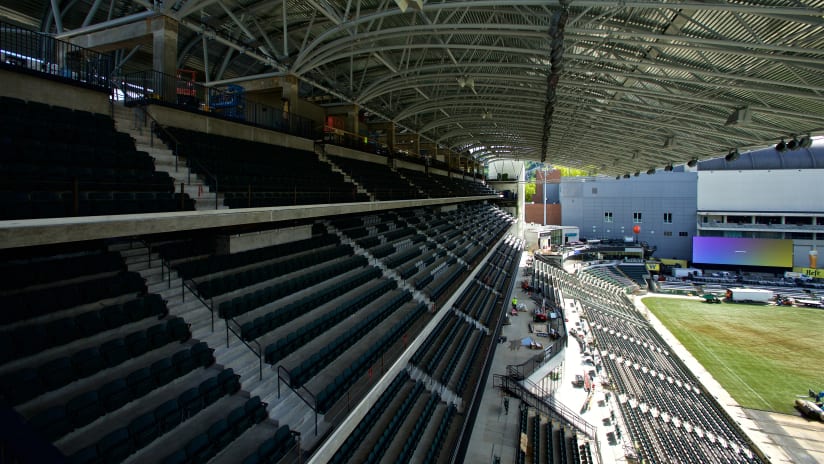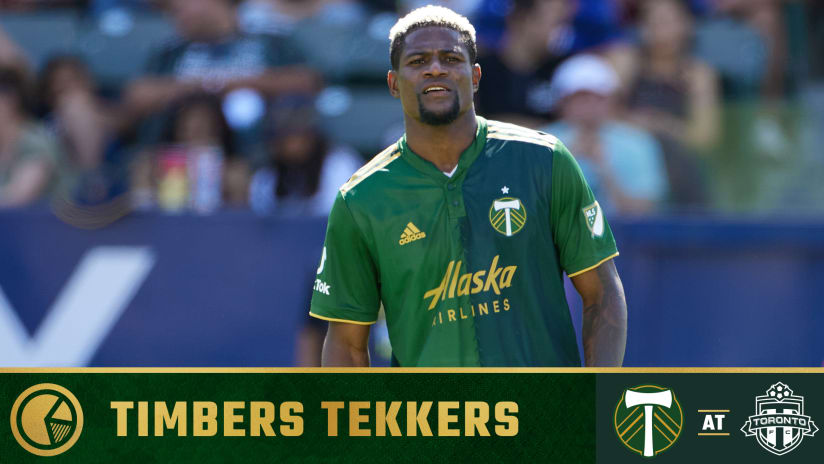PORTLAND, Ore. – There came a point during Providence Park’s renovation that a chance to add seats to the stadium’s east side became a broader opportunity, one that could not only include improvements to other parts of the venue but see ideas made possible by the east’s new infrastructure be sprinkled throughout the park.
To a certain extent, we saw some of that approach in details of the west and north sides’ improvements. The vitality that comes with Providence Park’s new flank is being replicated throughout the corridors, concession stands, and signage within the stadium’s other arms. Those arms of the venues may not be new, but they will have a new feel.
One of the ways that feel gets shared is the stadium’s technology. Modernized digital displays will be the most obvious improvement, but lighting, speakers, wireless internet access and stadium displays will also add to the in-park experience, with almost all improvements made possible by a network infrastructure that has, within the stadium’s core, moved a 1926 concept closer to our 2019 world.
You start with the scoreboards. Physically, they are the biggest technological improvements to the part, although the display at the stadium’s south end is no bigger than the one it replaces. The differences, though, are the losses of the static signboards across the monitor’s sides and the upgrades to the display technology, itself. The video is better, more versatile, and more adaptable thanks to every inch of the field-facing board being subject to a finger tip’s control.
Then there are the new boards, the most prominent of which will be above the stadium’s west side, facing back toward the field. Smaller than the south end’s more prominent display, the board to the north of the stadium’s press box offers the same virtues. The displays are sharper, brighter, and offer a heightened degree of control. There will be a new capability when it comes to what Timbers and Thorns staff can show Providence Park’s patrons. Instead of feeling static and obligatory, the visual elements can complement the show.
Those elements don’t stop with the two scoreboards. Across the front of each level with the new side’s terraces, as well as along the top of the KeyBank Club, digital displays will allow for a new level of interactivity with the stadium’s signboards. Elements that previously had to stay the same for Timbers, Thorns, and T2 games can now be customized, potentially giving each event at the stadium its unique feel. The new elevator tower serving the new side at the south will also be lined with digital displays. Even the Tillamook Cheese block next to the North End is going digital.
Farther from the field, displays are being prioritized, too. Concourses on the west and north sides will see menus digitized. Seven different locations throughout those sides will be have games on monitors, allowing those at concessions to stay better connected to the game. On the east side, displays will hang overhead for field-facing supporters and line the corridors of each deck. From any line, you should be able to see the game. There will be 12 televisions in each bay, 13 on the top level, with even bathrooms in Tanner Ridge allowing fans to stay connected to the action.
The stadium’s lighting has been modernized, too. Gone are the traditional light bulbs, the size of which forced operators consider the time needed to power up, power down; cool down, heat up. Modern LED technology will allow for the lights to go instantly on and off, as well as display a varying levels of brightness. The old-school lightning may have added to a venerable venue’s charm, but with a major renovation happening on one side, major improvements have been lined up for others.
- JOIN THE ORGANIZATION: Guest Services positions available!
That includes the stadium’s sound. Large, horn-shaped speakers hanging from wooden beams around the stadium’s pre-existing infrastructure have been replaced with upgraded technology, mirroring the quality that’s been put in place in Tanner Ridge. Having reached its expiration date, the stadium’s previous speaker system needed to be replaced. As with other aspects, the club elected to spread technology from the east side to the west and north.
Then there is the wireless access, something that will mostly impact fans on the east side, for now. Still, installing new WiFi 6, 2.5 gigabit-per-second infrastructure there is seen as the first step to spreading the technology throughout the park. It may take more time for the 90-year-old parts of the site to get up-to-date, but the goal is for the new wireless capabilities – ones that can be fully leveraged by coming Apple, Samsung, and similar devices into the future – to be available to all, in time.
Almost all of the new technologies are made possible by upgrades at the core. Providence Park was built during a time when coaxial cabling wasn’t a modern technology. In time, that, new phones, ethernet cabling and other base-level technologies have had to be incorporated into building. With the new edifice on the east, the current project didn’t have to worry about what existed before, but as the club looks to bring the entire venue to similar levels, it’s taken steps to upgrade the hardware that supports its communications network. The new scoreboards, displays, lighting, sound and wireless will have a modernized backbone providing support.
That may be the only element not readily apparent to the eye. The rest will have a direct impact on fans’ new experience. From turnstile to seat, arrival to departure, the look around Providence Park will be entirely different. And a lot of that difference relies on new technology at the park.













